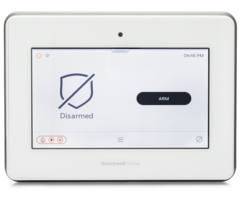PROA7 or PROA7PLUS: Entering Programming
Related Products

Description
In this video, Darrell from Alarm Grid shows users how to enter programming mode on a Honeywell Home PROA7 or PROA7PLUS, or on a Resideo PROA7C or PROA7PLUSC.
To enter programming, tap the menu icon in the bottom center of the screen. Scroll down to Tools, then enter the current Installer Code. The default Installer Code is 4112. This will bring you into the Installer Tools menu.
From here, select Programming from the available options. Once you enter programming, you can edit the number of partitions, add/edit/delete any peripheral devices, including Sensors, Key fobs, or keypads. In Z-Wave Peripherals, you can Include or Exclude devices. In the Users' programming, you can add/edit/delete user codes. In Panic Alarms, you can configure the keypad panic options, and in Advanced Settings, communicator and other system settings are configured.
In addition to system programming, the Installer Tools Menu can allow you to view System Information, Perform System Tests on both communicators and Sensors, Enable or Disable Local Alarm Mode, Change the Installer PIN, Default the panel back to factory settings, and Reboot the panel.
To exit programming when you're finished, choose the left arrow in the upper-left side of the screen to go back to the previous screen. Keep doing this until you return to the main Security Screen.
https://www.alarmgrid.com/faq/how-do-...
http://alrm.gd/get-monitored
Transcript
Hey, DIYers. This is Darrell with Alarm Grid. Today, we're going to talk about the PROA7 and PROA7PLUS and how to get into programming and some of the submenus inside the programming for the PROA7. The easiest way to get it is to hit the 3 line hamburger menu. You got your different options here. We always want to go to Tools. We use the installer code. The default is 4112. That takes us into the Tools menu for programming. You have system information, gives you a quick over guide of what's on the system, the panel Mac address CRC, a lot of the other hardware information, you get the system test which gives you your test options for the test communicator and the sensors, this gives you Test Wi-Fi, Test Cellular, Test All. You've got the Wi-Fi module and cellular modules installed. Test sensors takes you through another menu. Programming-- programming is where we do the meat of everything. This is where everything happens. You got your partitions, which tells you how many areas or sections of the home or building that you're using, peripherals is where all of your zones are listed, Z-Wave peripherals is where you're going to add by including or excluding Z-Wave devices. You have your users menu. You can set your panic alarms. You have the advanced settings, which is your communicator system reporter. This gives you the communicator information if you have one installed. We're going to take it back and we're going to go back out of programming, which I didn't mean to do, and we have the local alarm mode. You're going to want to see this menu when you first start setting up your panel because the local alarm mode allows you to set it up prior to us pulling the system online for you guys and ladies. The local alarm mode by default is off. But when you go to start setting it up, you'll have a menu that will tell you that it's on, and then you'll do all the rest of your setup. When we go to take it over the system, we'll put it online. We're going to ask you to come into the local alarm mode and disable that feature for us. The installer pin is where you change your installer code. If you wanted to change it, you can show it or change installer pin. The default options-- so if you ever need to default your panel for some reason-- say you're moving, you want to clear everything out for the system, or say there's something else going wrong, we just need to start factory fresh, that's where we do the factory default. Reboot system gives us the option to reboot the panel completely. It brings it back up like it was fresh, brand new. Not brand new, it's not default. It just reboots the system for you. And you would say, OK. And to back out of the program, you hit in the back arrow twice and that takes you back to the main menu. The biggest differences between the PROA7 and the PROA7PLUS is the PROA7 doesn't come with any additional hardware. It doesn't come with the Z-Wave card and the Wi-Fi card built in and it doesn't come with a takeover module, which is a separate module that has to be installed for 5,000 series devices. All right, DIYers, this wraps up our video on the PROA7 and the PROA7PLUS on how to get into and out of programming. If you have any questions on this process, you can reach out to us at support@alarmgrid.com, you can go to our website at alarmgrid.com. If you found the video helpful, you can like, subscribe, hit the bell notification icon. This will allow you to get notifications on when we create new content for our channel. My name is Darrell with Alarm Grid and have a great day.
- Uploaded



